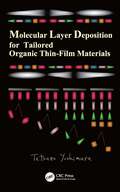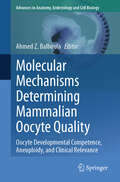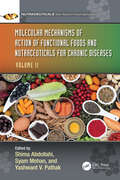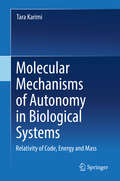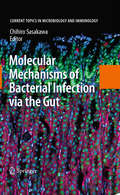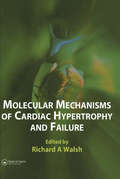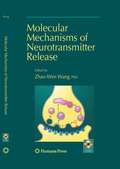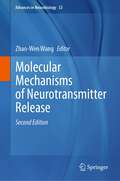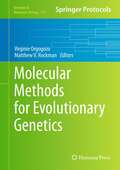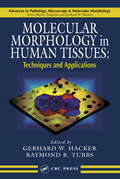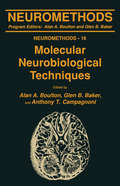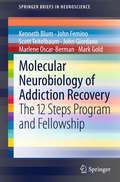- Table View
- List View
Molecular Interventions in Lifestyle-Related Diseases
by Toshikazu Yoshikawa Lester Packer Midori HiramatsuThe Japanese Ministry of Health, Labor and Welfare, officially recognizing that various risk factors for disease are present in our environment, has proposed the concept of lifestyle-related diseases. These include those diseases that are tied to such lifestyle choices as excessive alcohol consumption, cigarette smoking, exposure to stress, and poo
Molecular Layer Deposition for Tailored Organic Thin-Film Materials (Optics and Photonics)
by Tetsuzo YoshimuraThis book provides concepts and experimental demonstrations for various types of molecular layer deposition (MLD) and organic multiple quantum dots (organic MQDs), which are typical tailored organic thin-film materials. Possible applications of MLD to optical interconnects, energy conversion systems, molecular targeted drug delivery, and cancer therapy are also proposed. First, the author reviews various types of MLD processes including vapor-phase MLD, liquid-phase MLD, and selective MLD. Next, he introduces organic MQDs, which are typical tailored organic thin-film materials produced by MLD. The author then describes the design of light modulators/optical switches, predicts their performance, and discusses impacts of the organic MQDs on them. He then also discusses impacts of the organic MQDs on optical interconnects within computers and on optical switching systems. Finally, the author presents MLD applications to molecular targeted drug delivery, photodynamic therapy, and laser surgery for cancer therapy. This book is intended for researchers, engineers, and graduate students in optoelectronics, photonics, and any other field where organic thin-film materials can be applied.
Molecular Male Reproductive Medicine: Biology and Clinical Perspectives (Advances in Experimental Medicine and Biology #1469)
by C. Yan Cheng Fei SunThis book bridges the gap of basic research in male reproductive biology and its relationship to clinical studies. Bringing together a group of senior investigators with decades of experience in research and clinical investigation and keen interest in collaboration between the two areas, this book provides a balanced treatment of technical and basic research insights and cutting-edge findings, while introducing new ideas for clinical applications of this research. Section I is devoted to clinical aspects including testis biology, prostate biology, and spermatogenesis by senior investigators of male infertility treatment, particularly non-obstructive azoospermia. Section II presents the latest findings in male reproductive biology from a basic research perspective, as well as covering cutting-edge technology such as scRNA-Seq, scATAC-Seq, DNA chromatic accessibility and organization studies, genetic models, cell biology, molecular biology, and biochemistry on testis biology, and spermatogenesis. This book offers not only a cohesive summary of new findings and concepts in basic and clinical male reproductive research, it analyzes and assembles these concepts into a roadmap for the next decade of translational research, bringing lab discoveries to the bedside.
Molecular Mechanism of Congenital Heart Disease and Pulmonary Hypertension
by Toshio Nakanishi H. Scott Baldwin Hiroyuki Yamagishi Jeffrey R. FinemanThis open access book focuses on the molecular mechanism of congenital heart disease and pulmonary hypertension, offering new insights into the development of pulmonary circulation and the ductus arteriosus. It describes in detail the molecular mechanisms involved in the development and morphogenesis of the heart, lungs and ductus arteriosus, covering a range of topics such as gene functions, growth factors, transcription factors and cellular interactions, as well as stem cell engineering technologies. The book also presents recent advances in our understanding of the molecular mechanism of lung development, pulmonary hypertension and molecular regulation of the ductus arteriosus. As such, it is an ideal resource for physicians, scientists and investigators interested in the latest findings on the origins of congenital heart disease and potential future therapies involving pulmonary circulation/hypertension and the ductus arteriosus.
Molecular Mechanisms Determining Mammalian Oocyte Quality: Oocyte Developmental Competence, Aneuploidy, and Clinical Relevance (Advances in Anatomy, Embryology and Cell Biology #238)
by Ahmed Z. BalboulaAs the age of childbearing increases, reduced female gamete (egg) quality has emerged as the primaery cause of infertility in women. This book addresses molecular mechanisms that regulate oocyte quality as well as intrinsic and extrinsic factors that compromise these mechanisms. Eggs are produced through a unique cell division called meiosis. Oocyte meiosis is initiated early in fetal life. Shortly before birth, the oocyte undergoes a prolonged arrest at prophase I until the age of puberty, at which selected oocytes resume meiosis I. Following meiotic resumption and during oocyte maturation, tight regulation of nuclear and DNA-related mechanisms ensures proper homologous chromosome segregation prior to another arrest at metaphase II. Any errors prior to completion of meiosis I can lead to chromosome segregation errors and aneuploidy, the most common genetic cause of miscarriage and congenital disorders such as Down syndrome. In addition to nuclear maturation, several cytoplasmic processes are orchestrated to support cell division and to generate developmentally competent eggs capable of supporting fertilization and early embryonic development. The interaction between these nuclear and cytoplasmic processes is critical for producing good-quality oocytes. This volume in the Advances in Anatomy, Embryology and Cell Biology book series presents current reviews by leading experts. It offers valuable insights for researchers, physicians and Ph.D. students interested in reproductive biology, particularly oocyte quality and meiosis.
Molecular Mechanisms in Nutritional Epigenetics (Epigenetics and Human Health #12)
by Luis M. VaschettoThis volume in the Epigenetics and Human Health series explores the intersection of diet and epigenetic modifications. It provides the reader with the latest research on how diet can influence our genetic and epigenetic profiles, thereby affecting our health and susceptibility to disease. In recent years, the field of nutritional epigenetics/nutri-epigenetics has expanded significantly, shedding light on how environmentally-driven epigenetic pathways can be modulated through nutrition and eating habits. The book provides a comprehensive introduction to the various epigenetic mechanisms affected by dietary compounds and focuses on specific topics such as the relationship between diet and the gut microbiome, the impact of diet on cardiovascular disease and psychopathology and the role of diet in pregnancy. Written by an international team of experts, this book reveals the molecular mechanisms underlying the influence of diet on epigenetic modifications and discusses the prospect of personalized medicine using dietary strategies to promote well-being and protect against diseases. The book is aimed at researchers and students in the fields of human nutrition, genetics, and medicine.
Molecular Mechanisms in the Pathogenesis of Idiopathic Nephrotic Syndrome
by Kazunari KanekoThis comprehensive book reviews our current state of knowledge about the pathogenesis of idiopathic nephrotic syndrome (INS), which comprises a heterogeneous group of diseases with distinct histological characteristics, such as minimal-change nephrotic syndrome (MCNS), focal segmental glomerulosclerosis (FSGS), and idiopathic membranous nephropathy (IMN). As the word "idiopathic" indicates, the pathogenesis of INS remains unclear. Historically, T-cell dysfunction has been thought to play an important part in the pathogenesis of MCNS, while circulating vascular permeabilities have been believed to induce proteinuria in FSGS. The book further describes recent advances in molecular biology, which have allowed us to speculate on the interactions between visceral glomerular epithelial cells (podocytes) and the relative significance of several molecules in the pathogenesis of INS, such as reactive oxygen species, nuclear factor-kappa B, CD80, angiopoietin-like 4, cardiotrophin-like cytokine-1, and M-type phospholipase A2 receptor. The normally rapid pace of scientific progress occasionally devolves into a state of chaos, and the pathogenetic research on INS is one such case. This volume will help researchers and scientists to collaborate, share resources, and expedite the design of protocols to evaluate the putative factors.
Molecular Mechanisms of Action of Functional Foods and Nutraceuticals for Chronic Diseases: Volume II (Nutraceuticals)
by Yashwant V. Pathak Syam Mohan Shima AbdollahiThere has been a global rise in the incidence of chronic illnesses, which may be partially attributed to the lengthening of the average human lifespan. Functional foods and nutraceuticals have a potential role to play in the development and maintenance of health. They can assist the body in its battle against inflammation and chronic illnesses.Molecular Mechanisms of Action of Functional Foods and Nutraceuticals for Chronic Diseases addresses the effects and mechanism of functional foods in relation to chronic diseases such as obesity, cardiovascular diseases, diabetes, cancer, etc. This volume, like the first volume Applications of Functional Foods and Nutraceuticals for Chronic Diseases, inspires new thought processes and a paradigm shift in research and development.Key Features: Discusses the molecular mechanism of action, the range of toxicities exerted by these food components for functional foods for addressing chronic conditions Enhances scientists and industrial personnel knowledge of functional foods and in the management of chronic diseases Presents research on the role of functional foods/nutraceuticals in preventing and treating chronic diseases through epigenetic modulation Explores various subjects such as epigenetics, immunological, metabolic, technological and neurodenerative aspects affected by functional foods in chronic diseases The world’s leading wellness centers for chronic diseases are using functional foods and nutraceuticals in their practice and discovering their useful applications, and this second of two volume set is another great reference for practitioners, scientists, and clinicians in the management of chronic diseases. Contributors hail from different geographical locations around the world and have many years of research and scholarly experience in functional foods, nutraceuticals, and biology.
Molecular Mechanisms of Action of Polyphenols Against Cancer: Experimental and in silico Evaluations
by Jayanta Kumar Patra J. Basilio Heredia Nayely Leyva-López Laura Aracely Contreras-Angulo Erick Paul Gutiérrez GrijalvaRecent and ongoing epidemiological studies point to the beneficial health effects of dietary polyphenols, with evidence suggesting that individuals with a high intake of polyphenol-rich foods have less incidence of noncommunicable diseases like diabetes, cardiovascular problems, and cancer. Multidisciplinary research on dietary polyphenols and what causes them to exert such benefits has led to discoveries which can help us to understand the mechanisms of action of these molecules, including the structure-activity relationships of polyphenols, the modulatory effects exerted on enzymes, reactive oxygen species, protein interactions, and the regulation of expression of some transcription factors. In recent years, increased interest in bioinformatic studies has helped scientists predict and evaluate the interactions of polyphenols with protein targets involved in the onset and development of different types of cancer. Likewise, in silico evaluations coupled with experimental studies are a rising trend in many research areas. This contributed volume critically summarizes the experimental and in silico molecular mechanisms of action of dietary polyphenols, including phenolic acids, anthocyanins, flavanols, flavanones, and flavones against cancer. It is designed for researchers in academia and industry focused on cancer immunology and therapeutics, medicinal chemistry, and food science (functional foods, nutraceuticals, natural products, food technology), as well as graduate students preparing for a career in these areas.
Molecular Mechanisms of Angiogenesis
by Jean-Jacques Feige Gilles Pagès Fabrice SoncinAngiogenesis is a multi-stage process that drives the generation of new blood and lymphatic vessels from pre-existing ones. It is highly active during embryogenesis, largely inactive during adulthood but reactivated during wound healing and under a number of pathological conditions including cancer and ocular diseases. In addition to endothelial cells, which line the walls of the vessels, several other cell types (pericytes, macrophages, progenitor cells. . . ) also contribute to angiogenesis. A number of signaling pathways are activated and very finely tune the delicate morphogenetic events that ultimately lead to the formation of stable blood proof neovessels. This book reviews recent advances in our understanding of the molecular and cellular mechanisms of angiogenesis, with a focus on how to integrate these observations into the context of developmental, post-natal and pathological neovascularization. The book was published under the auspices of the French Angiogenesis Society. Most contributors are prominent members of this Society or international researchers who have actively contributed to the Annual Meetings of the Society.
Molecular Mechanisms of Autonomy in Biological Systems: Relativity of Code, Energy and Mass
by Tara KarimiThis book presents a novel molecular description for understanding the regulatory mechanisms behind the autonomy and self-organization in biological systems. Chapters focus on defining and explaining the regulatory molecular mechanisms behind different aspects of autonomy and self-organization in the sense of autonomous coding, data processing, structure (mass) formation and energy production in a biological system. Subsequent chapters discuss the cross-talk among mechanisms of energy, and mass and information, transformation in biological systems. Other chapters focus on applications regarding therapeutic approaches in regenerative medicine. Molecular Mechanisms of Autonomy in Biological Systems is an indispensable resource for scientists and researchers in regenerative medicine, stem cell biology, molecular biology, tissue engineering, developmental biology, biochemistry, biophysics, bioinformatics, as well as big data sciences, complexity and soft computing.
Molecular Mechanisms of Bacterial Infection via the Gut
by Chihiro SasakawaOur gut is colonized by numerous bacteria throughout our life, and the gut epithelium is constantly exposed to foreign microbes and dietary antigens. Thus, the gut epithelium acts as a barrier against microbial invaders and is equipped with various innate defense systems. Resident commensal and foreign invading bacteria interact intimately with the gut epithelium and can impact host cellular and innate immune responses. From the perspective of many pathogenic bacteria, the gut epithelium serves as an infectious foothold and port of entry for disseminate into deeper tissues. In some instances when the intestinal defense activity and host immune system become compromised, even commensal and opportunistic pathogenic bacteria can cross the barrier and initiate local and systematic infectious diseases. Conversely, some highly pathogenic bacteria, such as those highlighted in this book, are able to colonize or invade the intestinal epithelium despite the gut barrier function is intact. Therefore, the relationship between the defensive activity of the intestinal epithelium against microbes and the pathogenesis of infective microbes becomes the basis for maintaining a healthy life. The authors offer an overview of the current topics related to major gastric and enteric pathogens, while highlighting their highly evolved host (human)-adapted infectious processes. Clearly, an in-depth study of bacterial infectious strategies, as well as the host cellular and immune responses, presented in each chapter of this book will provide further insight into the critical roles of the host innate and adaptive immune systems and their importance in determining the severity or completely preventing infectious diseases. Furthermore, under the continuous threat of emerging and re-emerging infectious diseases, the topic of gut-bacteria molecular interactions will provide various clues and ideas for the development of new therapeutic strategies.
Molecular Mechanisms of Cardiac Hypertrophy and Failure
by Richard A. WalshThis title reviews current knowledge of the mechanisms contributing to heart failure. Editor Richard Walsh and an internationally renowned team of contributors discuss key advances in molecular and cell biology, biochemistry, and pharmacology, focusing on advances that have a direct bearing on current clinical studies. It highlights developments across a broad range of disciplines, with in-depth coverage of each topic providing background and perspective on current literature. By setting new advances in a broader context, this text allows readers to compare different ideas and evaluate their importance in their own areas of research or clinical practice.
Molecular Mechanisms of Inflammation: Induction, Resolution and Escape by Helicobacter pylori (Current Topics in Microbiology and Immunology #421)
by Steffen BackertThis book focuses on immune reactions and interactions of humans with Helicobacter pylori - a human pathogen connected to gastritis, peptic ulcers and even gastric cancer. With nearly half of the world’s population colonized, it has been characterized as one of the most successful pathogens for more than 100,000 years of co-evolution with its host. The respective chapters discuss not only how H. pylori infection is considered a paradigm for persistent bacterial infection and chronic inflammation, but also how the infection might be connected to host protection against gastro-esophageal diseases, asthma, and other allergic disease manifestations. Readers will gain essential insights into the roles of specific factors in the immune response and learn about the impact of genetic polymorphisms on the risk of gastric carcinogenesis. In addition, the book discusses the strategies used by this bacterium, which allow it to colonize specific sites in the stomach, interact with the microbiome, evade immune surveillance and undermine the resolution of inflammation during persistent infection. This volume presents a concise summary of recent advances in the areas of induction, resolution and escape of inflammation, innate and adaptive immunity, gastric disease development, as well as treatment and vaccination against H. pylori. Accordingly, it offers a valuable asset for scientists and clinicians alike.
Molecular Mechanisms of Neurotransmitter Release
by Zhao-Wen WangWithin the complex neuronal network of the nervous system, neuron-to-neuron communication occurs mainly through chemical synapses, where the presynaptic nerve terminal releases neurotransmitters which control the function of postsynaptic neurons by acting on postsynaptic receptors. Recent decades have brought ground-breaking new developments and a wealth of knowledge to this field. In 'Molecular Mechanisms of Neurotransmitter Release', leading experts provide concise, up-to-date information on all major molecular mechanisms involved, with complete background information and figures and diagrams to further elucidate key concepts or experiments. Comprehensive and cutting-edge, 'Molecular Mechanisms of Neurotransmitter Release' is sure to provide a learning tool for neuroscience students, a solid reference for neuroscientists, and a source of knowledge for all those who have a general interest in the ever-evolving field of neuroscience
Molecular Mechanisms of Neurotransmitter Release (Advances in Neurobiology #33)
by Zhao-Wen WangNeurons communicate with each other by releasing neurotransmitters. This book provides comprehensive coverage of the molecular mechanisms involved in neurotransmitter release. The topics covered in the book range from the architecture and cytomatrix proteins of presynaptic sites, to the modes of synaptic vesicle exocytosis (full-collapse and kiss-and-run), and from the key molecules mediating synaptic vesicle fusion (SNAREs) to those that closely interact with them (UNC-13/Munc13, UNC-18/Munc18, tomosyn, and complexins). The book also delves into the calcium sensors of synaptic vesicle fusion (synaptotagmins and Doc2s), the sources of calcium that trigger synaptic exocytosis (voltage-gated calcium channels and ryanodine receptors), and the regulation of neurotransmitter release by potassium channels, cell adhesion molecules, lipids, aryl hydrocarbon receptor-interacting protein (AIP), presenilins, and calstabins. To aid in understanding and illustrate key concepts, the book includes sufficient background information and a wealth of illustrations and diagrams. The new edition includes major updates to previous chapters, as well as several new chapters that reflect the recent advances in the field. Comprehensive and cutting-edge, Molecular Mechanisms of Neurotransmitter Release, 2nd edition, is a valuable learning resource for neuroscience students and a solid reference for neuroscientists.
Molecular Mechanisms of Retina Pathology and Ways of its Correction
by Svetlana TrofimovaThis book discusses the pathology of the retina, and reviews current research on the use of cell replacement therapy and short peptides to restore functional activity in retinal neurons. As the book describes, pathologies of the retina, including age-related macular degeneration, diabetic retinopathy, and retinitis pigmentosa, present a long-standing challenge in the practice of clinical ophthalmology. Modern treatment for these conditions, which lead to irreversible blindness, includes laser exposure, surgical intervention, and drugs. These treatments aim to reduce the risk of new complications in the eye; pathogenetic therapy of degenerative diseases of the retina is practically absent in current ophthalmic practice. The first section of the book reviews the molecular mechanisms of age-related macular degeneration, diabetic retinopathy, and retinitis pigmentosa, and reports on methods of treatment. The second section presents the results of recent experimental studies of the effects of short peptides on pluripotent embryonic cells; on proliferative activity in retinal cells and pigment epithelium; on expression of markers of differentiation or retinal neurons and pigment epithelium; and on the course of hereditary retinal pigmentation in Campbell rats. The third section offers results of clinical studies on the effectiveness of short peptides in patients with macular degeneration, and in patients with retinitis pigmentosa. The author concludes that the regular use of peptides in the treatment of degenerative diseases of the retina can slow the progression of the pathological process and preserve the patient’s vision for some 10-15 years. In addition, in 80 percent of patients, it is possible to increase visual function by increasing visual acuity, improving the boundaries of the visual field and the fundus.
Molecular Mechanisms of Tumor Cell Resistance to Chemotherapy: Targeted Therapies to Reverse Resistance
by Benjamin BonavidaThis volume gives the latest developments in on the mechanisms of cancer cell resistance to apoptotic stimuli, which eventually result in cancer progression and metastasis. One of the main challenges in cancer research is to develop new therapies to combat resistant tumors. The development of new effective therapies will be dependent on delineating the biochemical, molecular, and genetic mechanisms that regulate tumor cell resistance to cytotoxic drug-induced apoptosis. These mechanisms should reveal gene products that directly regulate resistance in order to develop new drugs that target these resistance factors and such new drugs may either be selective or common to various cancers. If successful, new drugs may not be toxic and may be used effectively in combination with subtoxic conventional drugs to achieve synergy and to reverse tumor cell resistance. The research developments presented in this book can be translated to produce better clinical responses to resistant tumors.
Molecular Medicine: An Introduction
by Cy Aaron Stein Jens KurreckDiscover the future of medicine in this extensively updated edition of the pioneering textbook, reflecting the rapid progress in the field Molecular medicine is a rapidly growing field, and the molecular basis of diseases can be used to develop therapeutic approaches in numerous other medical subfields. Research into molecular medicine has been used as the basis for gene therapy, precision medicine, and more. Molecular Medicine provides a fundamental overview of this cutting-edge, interdisciplinary field, incorporating modules from basic immunology to virology to new approaches. Now fully updated to reflect the exponential progress in biomedical research, it promises to put students on the leading edge of a revolution in the life sciences. Readers of the second edition of Molecular Medicine will also find: Detailed discussion of cutting-edge topics including cancer stem cells, mRNA vaccines, organs-on-a-chip, and moreProfessional artwork throughoutChapter summaries, exercises, and study questions for each chapter Molecular Medicine is ideal for graduate students in life sciences and medicine, as well as the lecturers and libraries that support them.
Molecular Medicine: How Science Works
by Carsten Carlberg Ferdinand Molnár Eunike VelleuerThe fascinating area of molecular medicine provides a molecular and cellular description of health and disease. Starting with the understanding of gene regulation and epigenetics, i.e., the interplay of transcription factors and chromatin, this book will provide an fundamental basis of nearly all processes in physiology, both in health as well as in most common disorders, such as cancer, diabetes as well as in autoimmune diseases. Most non-communicable human diseases have a genetic (= inherited) as well as an epigenetic component. The later one is based on our lifestyle choices and environmental exposures. Many common diseases, such as type 2 diabetes, can be explained only to some 20% via a genetic predisposition. We cannot change the genes that we are born with but we can take care of the remaining 80% being primarily based on our epigenome. Therefore, there is a high level of individual responsibility for staying healthy. Thus, not only biologists and biochemists should be aware of this topic, but all students of biomedical disciplines will benefit from being introduced into the concepts of molecular medicine. This will provide them with a good basis for their specialized disciplines of modern life science research. The book is subdivided into 42 chapters that are linked to a series of lecture courses in “Molecular Medicine and Genetics”, “Molecular Immunology”, “Cancer Biology” and “Nutrigenomics” that is given by one of us (C. Carlberg) in different forms since 2002 at the University of Eastern Finland in Kuopio. This book represents an updated version and fusion of the books textbooks “Mechanisms of Gene Regulation: How Science Works” (ISBN 978-3-030-52321-3), “Human Epigenetics: How Science Works” (ISBN 978-3-030-22907-8). “Molecular Immunology: How Science Works” (ISBN 978-3-031-04024-5), “Cancer Biology: How Science Works” (ISBN 978-3-030-75699-4) and “Nutrigenomics: How Science Works” (ISBN 978-3-030-36948-4). By combining basic understanding of cellular mechanism with clinical examples, the authors hope to make this textbook a personal experience. A glossary in the appendix will explain the major specialist’s terms.
Molecular Medicines for Cancer: Concepts and Applications of Nanotechnology
by Ram I. Mahato Deepak Chitkara Anupama MittalThe field of molecular medicine covers the medical interventions targeting molecular structures and mechanisms that are involved in disease progression. In cancer, several molecular mechanisms have been shown to impact its progression, aggressiveness and chemoresistance. Increasing evidence demonstrates the role of nanotechnology and outcome of molecular therapy. Several books have discussed molecular biology and mechanisms involved in cancer, but this text gives an account of molecular therapeutics in cancer relating to advancements of nanotechnology. It provides a description of the multidisciplinary field of molecular medicines and its targeted delivery to cancer using nanotechnology. Key Features: Provides current information in the multidisciplinary field of molecular medicines and its targeted delivery to cancer using nanotechnology Presents important aspects of nanotechnology in the site-specific delivery of anticancer agents Includes up to date information on oligonucleotide and gene based therapies in cancer Describes small targeted molecules, antibodies and oligonucleotides which have shown to selectively target the molecular structures thereby influencing signal transduction Facilitates discussion between researchers involved in cancer therapy and nanoscientists
Molecular Methods for Evolutionary Genetics
by Matthew V. Rockman Virginie OrgogozoWe are entering a particularly fruitful period in evolutionary genetics, as rapid technological progress transforms the investigation of genetic variation within and between species. Molecular Methods for Evolutionary Genetics is a collection of advanced molecular biology protocols and general overviews intended to represent the essential methods currently bringing evolutionary genetics to fruition. Divided into six thematic sections, this volume covers methods for characterizing genomes, diverse approaches to enrich DNA for subsets of the genome prior to sequencing, and state-of-the-art protocols for sampling genetic variation for genetic mapping studies and population genetic studies (RAD sequencing, Sequenom, microarrays, etc.). The volume concludes by focusing on methods to study candidate genes, from obtaining their sequences and analyzing their transcripts to experimentally manipulating their activities in vivo. Written in the highly successful Methods in Molecular BiologyTM series format, chapters contain introductions to their respective topics, lists of the necessary materials and reagents, step-by-step, readily reproducible laboratory protocols, and notes on troubleshooting and avoiding known pitfalls. Authoritative and accessible, Molecular Methods for Evolutionary Genetics serves as a rich resource to biologists interested in evolution, whether they be specialists or beginners in molecular biology.
Molecular Morphology in Human Tissues: Techniques and Applications (Advances in Pathology, Microscopy, & Molecular Morphology)
by Gerhard W. Hacker Raymond R. TubbsMolecular Morphology in Human Tissues: Techniques and Applications presents the most advanced molecular morphological techniques to date. This integrated approach to molecular morphology provides powerful analytical and diagnostic tools at the genome level, making the diagnosis and management of cancer, viral infections, and other diseases more pre
Molecular Neurobiological Techniques
by Alan A. Boulton Glen B. Baker Anthony T. CampagnoniMolecular Neurobiological Techniques explores the principles and techniques of molecular biology that have had a great impact on current investigations into the structure and function of the nervous system. It offers a solid basis for understanding how specific techniques are used to approach major neurobiological problems.
Molecular Neurobiology of Addiction Recovery
by Kenneth Blum Marlene Oscar-Berman John Femino John Giordano Mark Gold Scott TeitelbaumHumans are biologically programmed to seek out pleasurable experiences. These experiences are processed in the mesolimbic system, also referred to as the "reward center" of the brain, where a number of chemical messengers work in concert to provide a net release of dopamine in the Nucleus Accumbens. In some genetically predisposed individuals, addiction occurs when the mechanisms of the mesolimbic system are disrupted by the use of various drugs of abuse. Since Alcoholics Anonymous was founded in 1935, it's 12 step program of spiritual and character development has helped countless alcoholics and drug addicts curb their self-destructive behaviors. However, the program was developed at a time when comparatively little was known about the function of the brain and it has never been studied scientifically. This is the first book to take a systematic look at the molecular neurobiology associated with each of the 12 steps and to review the significant body of addiction research literature that is pertinent to the program.

